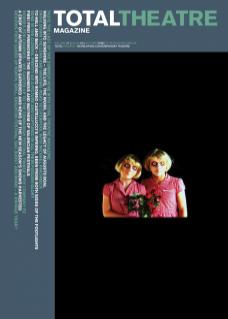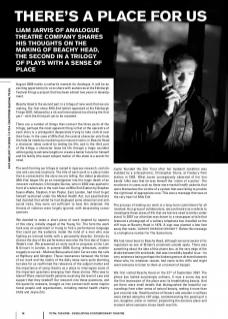August 2009 marks a cathartic moment for Analogue. It will be an exciting opportunity for us to share with audiences at the Edinburgh Festival Fringe a project that has been almost two years in development.
Beachy Head is the second part in a trilogy of new work that we are making. Our first show Mile End (which appeared at the Edinburgh Fringe 2007, followed by a UK and International tour) being the first part – with the third part yet to be revealed.
There are a number of things that connect the three parts of the trilogy; perhaps the most apparent thing is that at the epicentre of each story is a protagonist desperately trying to take control over their lives. In the case of Mile End, the central character only finds the help he needs by murdering an innocent victim; in Beachy Head, a character takes control by ending his life; and in the third part of the trilogy, a character loses his life through a tragic accident whilst going to extreme lengths to create a better future for himself and his family (the exact subject matter of this show is a secret for now).
The work forming our trilogy is rooted in rigorous research, real stories and concrete locations. The title of each work is a place name that is connected to the story we are telling. Our debut production, Mile End, began life as an investigation into the tragic death of an innocent commuter, Christophe Duclos, who in 2002 was pushed in front of a tube train in the rush hour at Mile End Station by Stephen Soans-Wade. Stephen, from Poplar, East London, had tried to get himself sectioned under the Mental Health Act, but psychiatrists had decided that whilst he had displayed some abnormal and antisocial traits, they were not sufficient to have him detained. His threats of violence were largely ignored, with devastating consequences.
We decided to make a short piece of work inspired by aspects of this story, initially staged at the Young Vic. The form the work took was an experiment in trying to find a performance language that could put the audience inside the mind of a man who was fighting an internal battle with a personality disorder. Entirely by chance the day of the performance was also the first day of Soans-Wade’s trial. We presented an early work-in-progress at the Lion & Unicorn in London, in summer 2006. During rehearsals, another tragedy occurred – Mehmet Bala pushed John Curran onto the rails at Highbury and Islington. These resonances between the fiction of our work and the reality of the daily news were quite alarming, but also for us reaffirmed the relevance of the subject matter and the importance of using theatre as a place to interrogate some of the important questions emerging from these stories. Who was to blame? Were mental health patients receiving the level of care and support that they needed? Our research into these questions, and the quest for answers, brought us into contact with some inspirational people and organisations, including mental health charity SANE and Jayne Zito.
Jayne founded the Zito Trust after her husband Jonathan was stabbed by a schizophrenic, Christopher Clunis, at Finsbury Park station in 1992. What Jayne courageously observed of her husbands’ killer was that he was himself the ‘victim of a policy’. The murderers in cases such as these were mental health patients that were themselves the victims of a system that was failing to provide the right level of appropriate care. This was a message that was at the very heart of Mile End.
The process of making our work is a long-term commitment for all involved. As a group of collaborators, we use theatre as a vehicle to investigate those areas of life that we feel we need to better understand. In 2007 our attention was drawn to a newspaper article that featured a photograph of a solitary telephone box installed on the cliff tops at Beachy Head in 1976. A sign was planted a few feet away that reads, ‘ALWAYS THERE DAY OR NIGHT’. Below this message is a telephone number for The Samaritans.
We had never been to Beachy Head, although we were aware of its reputation as one of Britain’s prominent suicide spots. There was something about the idea of this phone box, at the very edge of the divide between life and death, that was incredibly hopeful to us – its very existence being perhaps the kindest gesture directed towards those who, for whatever reason, had come to the cliffs and might want someone to listen to them at a moment of despair.
We first visited Beachy Head on the 22nd of September 2007. The phone box looked surprisingly ordinary. It was a sunny day and the first impression of the place was its breathtaking beauty. And yet there were small details that distinguished the beautiful surroundings from other areas of natural beauty, making it more than just a tourist site. Small bunches of flowers and wooden crucifixes were dotted along the cliff edge, commemorating the passing of a son, daughter, sister or mother; pinpointing the decisive place and moment when someone chose death over life.
On this first trip we found ourselves much closer to the subject matter than we had anticipated; from the gardens of The Beachy Head pub we witnessed in the distance the sight of the police and local chaplaincy team comforting the grieving relatives of Melanie Wells (wife of Sussex cricketer, Alan Wells) who had jumped earlier that morning. Witnessing this tragic aftermath from afar, the ethical dilemmas of making art about this incredibly sensitive subject became very real for us. We spent the day and into the night up on the cliffs, walking the two or three miles to the old Belle Tout lighthouse and back. We continued for some weeks after to try and make sense of our project and whether we should continue with it. What good could staging this kind of grief possibly do?
When creating a project over a long period of time, frequently the initial objectives change. As you begin to go down one path of inquiry, real life presents itself in sometimes shocking and surprising ways. Such was the case with news of the extraordinarily sad deaths of the Puttick family which made the headlines in May 2009. (The body of five-year-old Sam Puttick was found in a rucksack, together with the bodies of his parents, Kazumi Puttick and Neil Puttick, at the foot of Beachy Head. It was later revealed that the severely disabled child had died from meningitis at his home four days earlier, and his parents had decided that they couldn’t live without him).
Whilst the timing of these events has coincided with our project, tragic events at Beachy Head are not uncommon and the timing is less coincidental than it might seem. On average, twenty people take their lives at Beachy Head every year. It could be argued that there would never be a right time to investigate Beachy Head; art would always be far too close to real life wouldn’t it? For this reason the journey of this play has been one long investigation into the ethics of telling such stories, focusing increasingly on those who are left behind.
With an Arts Award from the Wellcome Trust’s Engaging Science programme we were able to invest two years into the research process, interviewing pathologists and forensic psychologists, members of the Samaritans and bereavement counsellors. We also met those who had previously attempted suicide as well as relatives and friends of those who had taken their own lives. From these encounters, we are painfully aware that this subject continues to be an enigma. All too frequently those who are left behind cannot determine definitive reasons or understand the motivations that compelled such an act.
Whether people go to the theatre to avoid or embrace real life is another debatable subject. Theatre exploring the bleaker facets of life is likely to have little appeal in the current climate isn’t it? So why spotlight an issue that has so few answers? We think it comes down to a need to openly ask informed questions in the only way we really know how; to let our characters ask those questions for us.
Liam Jarvis is, with Hannah Barker, Co-Artistic Director of Analogue. Beachy Head plays at the Pleasance Dome at 5.25pm daily throughout the Edinburgh Festival Fringe (no shows 17, 24 or 31 August). Book tickets at www.edfringe. com or www.pleasance.co.uk
For further information on the company, and for future plans for this show, see www.analogueproductions.co.uk or email producer Ric Watts on ric@ricwatts.com
The Zito Trust, cited in this article, is a charity working to reform mental health policy and law, and to provide advice and support to victims of mentally disordered offenders. See www.zitotrust.co.uk
The Samaritans provides confidential non-judgemental emotional support, 24 hours a day, for people who are experiencing feelings of distress or despair, including those which could lead to suicide. Further information on the organisation and details of how to make a donation to help their work, or how to train as a volunteer, can be found at www.samaritans.org


